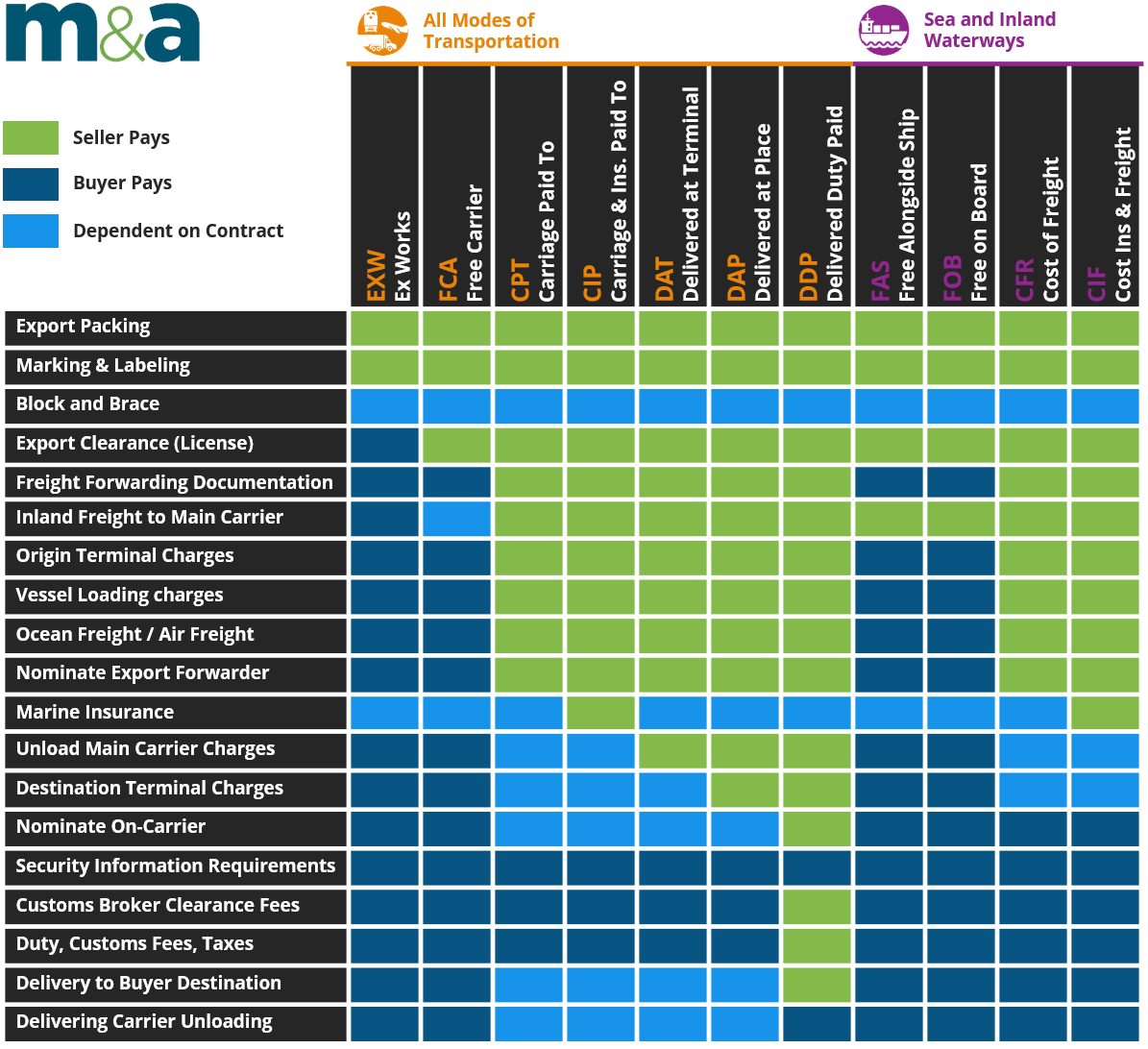What are Incoterms?
The INternational COmmerce Terms (Incoterms) were created by the International Chamber of Commerce (ICC) in 1936. The latest version of Incoterms, released in 2010 includes 11 separate codes for various modes of transportation. The terms are anticipated to undergo revision in 2020.
What are they used for?
The terms are universally used to determine the payment, shipping, and risk obligations held by the two parties (seller and buyer) during the shipping process.
Incoterms are universally used in international trade and, in some cases, domestic trade. They reduce the possibility of confusion during the shipping process and define the key parts of freight forwarding.
What are the Current Incoterms?
The Incoterms are divided into four categories:
- C Terms: Require the seller to pay for shipping
- D Terms: The seller or shipper's responsibility ceases at a specified point, they then deal with who will pay pier, docking, and clearance charges
- E Terms: When the goods are ready to leave the seller's premises, their responsibility ceases
- F Terms: The primary cost of shipping is not met by the seller
The current 11 Incoterms include:
- EXW (Ex Works)
- FCA (Free Carrier)
- CPT (Carriage Paid To)
- CIP (Carriage and Insurance Paid To)
- DAT (Delivered at Terminal)
- DAP (Delivered at Place)
- DDP (Delivered Duty Paid)
- FAS (Free Alongside Ship)
- FOB (Free on Board)
- CFR (Cost and Freight)
- CIF (Cost, Insurance, Freight)
EXW, FCA, CPT, CIP, DAT, DAP, and DDP apply to freight transported by all modes of transportation:
EXW (Ex Works) – The buyer is responsible for all Pre-Carriage, Main-Carriage, and On-Carriage costs associated with the shipment.FCA (Free Carrier) – The seller is responsible for Pre-Carriage and export fees. Ultimately, the buyer is responsible for Main-Carriage and On-Carriage. Most commonly used with International Air Shipments
CPT (Carriage Paid To) – The seller pays the freight for the carriage of the goods to the named destination. Ultimately, the seller is responsible for all charges accrued from door-to-door. This does not include insurance.
CIP (Carriage and Insurance Paid To) – The seller pays the freight for the carriage of the goods to the named destination. Ultimately, the seller is responsible for all charges accrued from door-to-door. This includes insurance.
DAT (Delivered at Terminal) – The seller is responsible for Pre-Carriage, Main-Carriage, loading and unloading, and export/import terminal charges, but all other charges including insurance and any additional On-Carriage Charges are the buyer’s responsibility.
DAP (Delivered at Place) – The seller is responsible for all Pre-Carriage and loading charges, Main-Carriage, and On-Carriage charges. Buyer is responsible for Duties/Customs.
DDP (Delivered Duty Paid) – The seller is responsible for all Pre-Carriage Main-Carriage, On-Carriage, and Duties/Customs. Buyer is responsible for delivery unloading charges.
FAS, FOB, CFR, and CIF are all specific to freight being transported by Sea and Inland Waterways:
FAS (Free Alongside Ship) – The seller fulfills his obligation to deliver when the goods have been placed alongside the vessel on the quay or in lighters at the named port of shipment. Ultimately, the seller is responsible for Pre-Carriage, but no export port fees, Main-carriage, or On-Carriage. The buyer pays export port fees, Main-Carriage, and On-Carriage, but no other Pre-Carriage charges.
FOB (Free on Board) – The seller fulfills his obligation to deliver when he places the goods on board (goods pass the vessel’s railing) at the port departure. Ultimately, the buyer is responsible for Main-carriage and On-Carriage, but not Pre-Carriage.
CFR (Cost and Freight) – The seller is responsible for all costs and freight associated with Pre-Carriage and Main-Carriage, but not On-Carriage. The buyer becomes responsible for all costs once the freight passes the vessel’s rail at the import port.
CIF (Cost, Insurance, Freight) – The seller delivers the goods on board the vessel or procures the goods already so delivered. The risk of loss or damage to the goods passes when the goods are on board the vessel. The seller must contract for and pay the costs and freight necessary to bring the goods to the named port of destination. The seller also contracts for insurance coverage against the buyer’s risk of loss or damage to the goods during the carriage. Ultimately, the seller is responsible for Pre-Carriage, Main-Carriage, and Insurance from door to import port. The buyer is responsible for On-Carriage.
Incoterms Chart
Below is a chart to simplify the basics of Incoterms:







